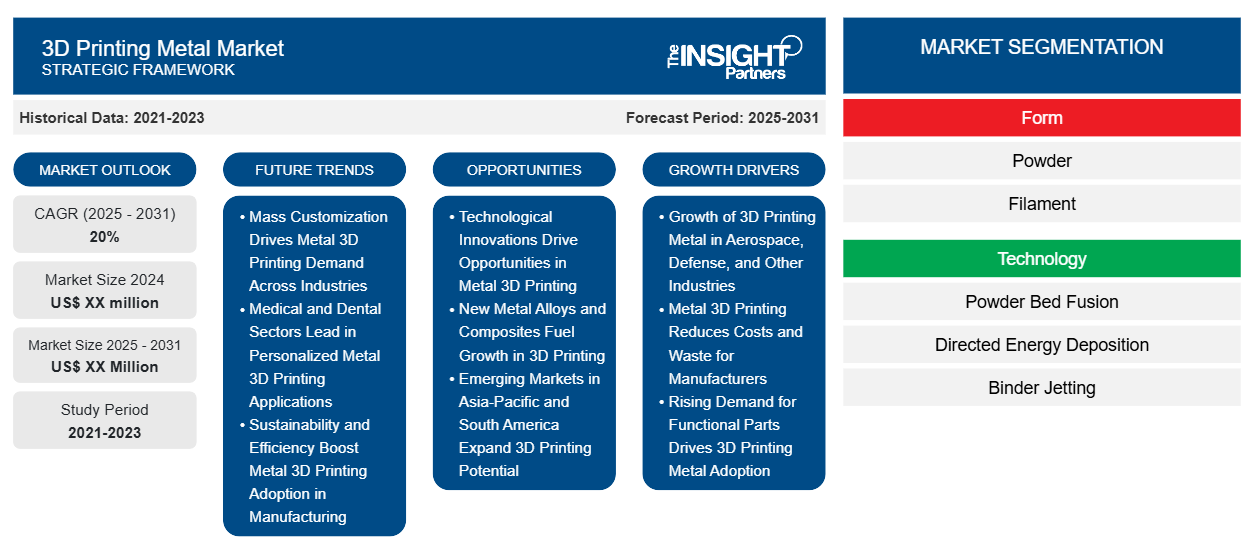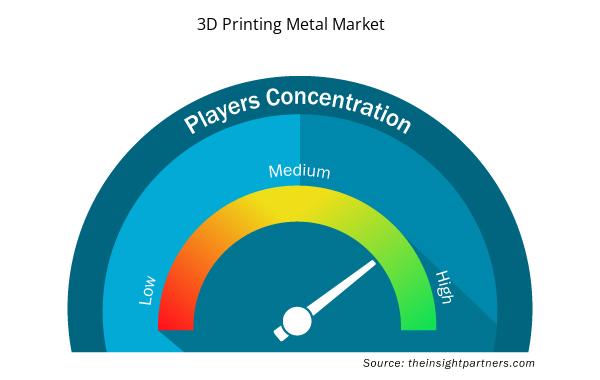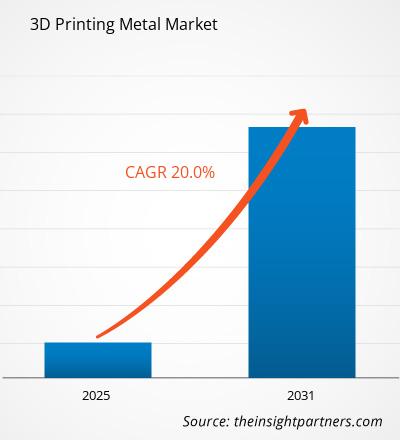Si prevede che il mercato della stampa 3D in metallo registrerà un CAGR del 20% dal 2025 al 2031, con una dimensione di mercato in espansione da XX milioni di dollari nel 2024 a XX milioni di dollari entro il 2031.
Il report di mercato del metallo per la stampa 3D è segmentato per forma (polvere e filamento). Il report presenta inoltre un'analisi basata sulla tecnologia (fusione a letto di polvere, deposizione di energia diretta, getto di legante, estrusione di metallo e altri). Il report è segmentato in base al tipo di metallo (titanio, nichel, acciaio inossidabile, alluminio e altri). Il report è inoltre analizzato in base al settore di utilizzo finale (aerospaziale e difesa, automobilistico, medico e altri). L'analisi globale è ulteriormente suddivisa a livello regionale e nei principali paesi. Le dimensioni e le previsioni del mercato a livello globale, regionale e nazionale per tutti i principali segmenti di mercato sono coperte nell'ambito. Il report offre il valore in USD per l'analisi e i segmenti di cui sopra.
Scopo del rapporto
Il report 3D Printing Metal Market di The Insight Partners mira a descrivere il panorama attuale e la crescita futura, i principali fattori trainanti, le sfide e le opportunità. Ciò fornirà spunti a vari stakeholder aziendali, come:
- Fornitori/produttori di tecnologia: per comprendere le dinamiche di mercato in evoluzione e conoscere le potenziali opportunità di crescita, consentendo loro di prendere decisioni strategiche informate.
- Investitori: condurre un'analisi completa delle tendenze relative al tasso di crescita del mercato, alle proiezioni finanziarie del mercato e alle opportunità esistenti lungo la catena del valore.
- Enti di regolamentazione: regolamentano le politiche e le attività di controllo sul mercato allo scopo di ridurre al minimo gli abusi, preservare la fiducia degli investitori e sostenere l'integrità e la stabilità del mercato.
Segmentazione del mercato dei metalli per la stampa 3D
Modulo
- Polvere
- Filamento
Tecnologia
- Fusione a letto di polvere
- Deposizione di energia diretta
- Getto di legante
- Estrusione di metallo
Settore di utilizzo finale
- Aerospaziale e difesa
- Automobilistico
- Medico
Tipo di metallo
- Titanio
- Nichel
- Acciaio inossidabile
- Alluminio
Personalizza questo report in base alle tue esigenze
Riceverai la personalizzazione gratuita di qualsiasi report, comprese parti di questo report, o analisi a livello nazionale, pacchetto dati Excel, oltre a usufruire di grandi offerte e sconti per start-up e università
Mercato dei metalli per la stampa 3D: approfondimenti strategici

- Scopri le principali tendenze di mercato in questo rapporto.Questo campione GRATUITO includerà analisi di dati che spaziano dalle tendenze di mercato alle stime e alle previsioni.
Driver di crescita del mercato della stampa 3D in metallo
- Crescita del metallo per stampa 3D nell'industria aerospaziale, della difesa e in altri settori: il mercato del metallo per stampa 3D sta vivendo una crescita significativa, guidata da vari fattori in diversi settori, come l'industria aerospaziale e della difesa, l'industria automobilistica, la medicina e l'odontoiatria e altri. L'industria aerospaziale e la difesa sono i maggiori consumatori di metallo per stampa 3D, poiché viene utilizzato per prototipi, parti di uso finale e persino sostituzioni rapide. La richiesta di materiali ad alte prestazioni, come quelli con condizioni di utilizzo estreme, come il titanio o l'alluminio, alimenta notevolmente la crescita di questo settore.
- La stampa 3D in metallo riduce i costi e gli sprechi per i produttori: i produttori traggono vantaggio dalla stampa 3D in metallo grazie ai costi di produzione ridotti e ai tempi di consegna minimi, generando al contempo sprechi minimi nel punto di produzione. Questa caratteristica attrae molti produttori che cercano di ottenere efficienza nei loro processi.
- La crescente domanda di parti funzionali spinge l'adozione della stampa 3D in metallo: la domanda di parti funzionali, in particolare nei settori manifatturieri come quello automobilistico e aerospaziale, sta diventando il principale motore di crescita. Le aziende di vari settori, come quello aerospaziale e della difesa, automobilistico e medico, hanno iniziato a utilizzare sempre di più la stampa 3D per realizzare parti che soddisfano specifici criteri di prestazione.
Tendenze future del mercato dei metalli nella stampa 3D
- La personalizzazione di massa spinge la domanda di stampa 3D in metallo in tutti i settori: c'è una tendenza crescente verso la personalizzazione di massa. Le aziende stanno sfruttando la stampa 3D in metallo per produrre qualcosa di specificamente su misura per un singolo cliente. La domanda in molti settori, tra cui medicina e aerospaziale, per un prodotto più personalizzato è in aumento.
- I settori medico e odontoiatrico sono leader nelle applicazioni di stampa 3D in metallo personalizzate: i settori medico e odontoiatrico sono uno dei principali mercati che utilizzano la stampa 3D in metallo per impianti personalizzati e apparecchi dentali. Le soluzioni mediche personalizzate sono destinate ad aumentare e questo è molto probabile che diventi una nuova tendenza.
- Sostenibilità ed efficienza aumentano l'adozione della stampa 3D in metallo nella produzione: un'altra tendenza nel mercato è la crescente attenzione alla riduzione dei tempi di produzione e di consegna e alla riduzione degli sprechi, che la stampa 3D in metallo offre intrinsecamente. Vari settori cercheranno pratiche di produzione più sostenibili, trovando quindi una crescita di mercato nell'efficienza delle tecnologie di stampa 3D in metallo. Inoltre, ci sarà una forte domanda di applicazioni di prototipazione perché varie aziende hanno bisogno di questa tecnologia per produrre e sviluppare rapidamente e in modo conveniente prototipi in metallo complessi.
Opportunità di mercato della stampa 3D in metallo
- Le innovazioni tecnologiche guidano le opportunità nella stampa 3D in metallo: si prevede che le innovazioni tecnologiche offriranno opportunità più redditizie per il mercato della stampa 3D in metallo durante il periodo di previsione. Esistono opportunità nell'esaminare e commercializzare nuove, efficienti e affidabili tecnologie di stampa 3D in metallo attraverso l'avanzamento della ricerca e dello sviluppo.
- Nuove leghe metalliche e compositi alimentano la crescita nella stampa 3D: lo sviluppo di nuove leghe metalliche e materiali compositi specificamente progettati per la stampa 3D offrirà maggiori opportunità di crescita. La nuova scienza dei materiali con parti più resistenti, leggere e durevoli sarà utilizzata per ottenere prestazioni eccellenti nelle parti stampate aerospaziali e automobilistiche. Vari attori che operano nel mercato si stanno anche concentrando sugli investimenti in attività di ricerca e sviluppo per offrire prodotti nuovi, innovativi e di alta qualità per soddisfare la domanda dei clienti.
- I mercati emergenti in Asia-Pacifico e Sud America espandono il potenziale della stampa 3D: inoltre, regioni emergenti come Asia-Pacifico e Sud America stanno diventando molto importanti nel panorama della stampa 3D in metallo. Queste regioni offrono spesso grandi opportunità alle aziende di stabilirsi lì e capitalizzare la crescente domanda di soluzioni di produzione di fascia alta.
Approfondimenti regionali sul mercato dei metalli per la stampa 3D
Le tendenze regionali e i fattori che influenzano il mercato del metallo per la stampa 3D durante il periodo di previsione sono stati ampiamente spiegati dagli analisti di Insight Partners. Questa sezione discute anche i segmenti e la geografia del mercato del metallo per la stampa 3D in Nord America, Europa, Asia Pacifico, Medio Oriente e Africa e America meridionale e centrale.

- Ottieni i dati specifici regionali per il mercato dei metalli per la stampa 3D
Ambito del rapporto sul mercato dei metalli per la stampa 3D
| Attributo del report | Dettagli |
|---|---|
| Dimensioni del mercato nel 2024 | XX milioni di dollari USA |
| Dimensioni del mercato entro il 2031 | XX milioni di dollari USA |
| CAGR globale (2025 - 2031) | 20% |
| Dati storici | 2021-2023 |
| Periodo di previsione | 2025-2031 |
| Segmenti coperti | Per modulo
|
| Regioni e Paesi coperti | America del Nord
|
| Leader di mercato e profili aziendali chiave |
|
Densità degli attori del mercato della stampa 3D in metallo: comprendere il suo impatto sulle dinamiche aziendali
Il mercato del mercato della stampa 3D in metallo sta crescendo rapidamente, spinto dalla crescente domanda degli utenti finali dovuta a fattori quali l'evoluzione delle preferenze dei consumatori, i progressi tecnologici e una maggiore consapevolezza dei vantaggi del prodotto. Con l'aumento della domanda, le aziende stanno ampliando le loro offerte, innovando per soddisfare le esigenze dei consumatori e capitalizzando sulle tendenze emergenti, il che alimenta ulteriormente la crescita del mercato.
La densità degli operatori di mercato si riferisce alla distribuzione di aziende o società che operano in un particolare mercato o settore. Indica quanti concorrenti (operatori di mercato) sono presenti in un dato spazio di mercato in relazione alle sue dimensioni o al valore di mercato totale.
Le principali aziende che operano nel mercato della stampa 3D in metallo sono:
- Stratasis
- Società anonima
- Materializzarsi
- Società per azioni Sandvik
- AB di Höganäs
Disclaimer : le aziende elencate sopra non sono classificate secondo un ordine particolare.

- Ottieni una panoramica dei principali attori del mercato della stampa 3D in metallo
Punti chiave di vendita
- Copertura completa: il rapporto esamina in modo completo i prodotti, i servizi, le tipologie e gli utenti finali del mercato della stampa 3D in metallo, offrendo una panoramica olistica.
- Analisi degli esperti: il rapporto è compilato sulla base della conoscenza approfondita di esperti e analisti del settore.
- Informazioni aggiornate: il rapporto garantisce la pertinenza aziendale grazie alla copertura di informazioni recenti e tendenze nei dati.
- Opzioni di personalizzazione: questo report può essere personalizzato per soddisfare le esigenze specifiche del cliente e adattarsi in modo appropriato alle strategie aziendali.
Il rapporto di ricerca sul mercato dei metalli per la stampa 3D può quindi aiutare a guidare il percorso di decodifica e comprensione dello scenario del settore e delle prospettive di crescita. Sebbene possano esserci alcune preoccupazioni valide, i vantaggi complessivi di questo rapporto tendono a superare gli svantaggi.
- Analisi storica (2 anni), anno base, previsione (7 anni) con CAGR
- Analisi PEST e SWOT
- Valore/volume delle dimensioni del mercato - Globale, regionale, nazionale
- Industria e panorama competitivo
- Set di dati Excel



Report Coverage
Revenue forecast, Company Analysis, Industry landscape, Growth factors, and Trends

Segment Covered
This text is related
to segments covered.

Regional Scope
North America, Europe, Asia Pacific, Middle East & Africa, South & Central America

Country Scope
This text is related
to country scope.
Domande frequenti
Based on geography, Europe held the largest share of the 3D printing metal market due to the well-established automotive and aerospace industry across the region.
Based on end-use industry, the aerospace and defense segment is expected to witness the fastest growth during the forecast period
ATI, Colibrium Additive, CRS Holdings LLC, GKN Powder Metallurgy, Kennametal Inc, Materialise NV, Sandvik, CNPC Powders, Höganäs AB, and INDO-MIM are some of the key players operating in the 3D printing metal market
Rising demand for 3D printing metals from the automotive and aerospace industry are driving the market growth
The 3D Printing Metal Market is estimated to witness a CAGR of 20% from 2023 to 2031
Rising demand for the customized products is expected to be the key market trends
Trends and growth analysis reports related to Chemicals and Materials : READ MORE..
The List of Companies
- Stratasys
- CRS Holdings, LLC.
- Materialise
- Sandvik AB
- Höganäs AB
- EOS
- Desktop Metal, Inc.
- SLM Solutions
- Sculpteo
- Markforged
The Insight Partners performs research in 4 major stages: Data Collection & Secondary Research, Primary Research, Data Analysis and Data Triangulation & Final Review.
- Data Collection and Secondary Research:
As a market research and consulting firm operating from a decade, we have published and advised several client across the globe. First step for any study will start with an assessment of currently available data and insights from existing reports. Further, historical and current market information is collected from Investor Presentations, Annual Reports, SEC Filings, etc., and other information related to company’s performance and market positioning are gathered from Paid Databases (Factiva, Hoovers, and Reuters) and various other publications available in public domain.
Several associations trade associates, technical forums, institutes, societies and organization are accessed to gain technical as well as market related insights through their publications such as research papers, blogs and press releases related to the studies are referred to get cues about the market. Further, white papers, journals, magazines, and other news articles published in last 3 years are scrutinized and analyzed to understand the current market trends.
- Primary Research:
The primarily interview analysis comprise of data obtained from industry participants interview and answers to survey questions gathered by in-house primary team.
For primary research, interviews are conducted with industry experts/CEOs/Marketing Managers/VPs/Subject Matter Experts from both demand and supply side to get a 360-degree view of the market. The primary team conducts several interviews based on the complexity of the markets to understand the various market trends and dynamics which makes research more credible and precise.
A typical research interview fulfils the following functions:
- Provides first-hand information on the market size, market trends, growth trends, competitive landscape, and outlook
- Validates and strengthens in-house secondary research findings
- Develops the analysis team’s expertise and market understanding
Primary research involves email interactions and telephone interviews for each market, category, segment, and sub-segment across geographies. The participants who typically take part in such a process include, but are not limited to:
- Industry participants: VPs, business development managers, market intelligence managers and national sales managers
- Outside experts: Valuation experts, research analysts and key opinion leaders specializing in the electronics and semiconductor industry.
Below is the breakup of our primary respondents by company, designation, and region:

Once we receive the confirmation from primary research sources or primary respondents, we finalize the base year market estimation and forecast the data as per the macroeconomic and microeconomic factors assessed during data collection.
- Data Analysis:
Once data is validated through both secondary as well as primary respondents, we finalize the market estimations by hypothesis formulation and factor analysis at regional and country level.
- Macro-Economic Factor Analysis:
We analyse macroeconomic indicators such the gross domestic product (GDP), increase in the demand for goods and services across industries, technological advancement, regional economic growth, governmental policies, the influence of COVID-19, PEST analysis, and other aspects. This analysis aids in setting benchmarks for various nations/regions and approximating market splits. Additionally, the general trend of the aforementioned components aid in determining the market's development possibilities.
- Country Level Data:
Various factors that are especially aligned to the country are taken into account to determine the market size for a certain area and country, including the presence of vendors, such as headquarters and offices, the country's GDP, demand patterns, and industry growth. To comprehend the market dynamics for the nation, a number of growth variables, inhibitors, application areas, and current market trends are researched. The aforementioned elements aid in determining the country's overall market's growth potential.
- Company Profile:
The “Table of Contents” is formulated by listing and analyzing more than 25 - 30 companies operating in the market ecosystem across geographies. However, we profile only 10 companies as a standard practice in our syndicate reports. These 10 companies comprise leading, emerging, and regional players. Nonetheless, our analysis is not restricted to the 10 listed companies, we also analyze other companies present in the market to develop a holistic view and understand the prevailing trends. The “Company Profiles” section in the report covers key facts, business description, products & services, financial information, SWOT analysis, and key developments. The financial information presented is extracted from the annual reports and official documents of the publicly listed companies. Upon collecting the information for the sections of respective companies, we verify them via various primary sources and then compile the data in respective company profiles. The company level information helps us in deriving the base number as well as in forecasting the market size.
- Developing Base Number:
Aggregation of sales statistics (2020-2022) and macro-economic factor, and other secondary and primary research insights are utilized to arrive at base number and related market shares for 2022. The data gaps are identified in this step and relevant market data is analyzed, collected from paid primary interviews or databases. On finalizing the base year market size, forecasts are developed on the basis of macro-economic, industry and market growth factors and company level analysis.
- Data Triangulation and Final Review:
The market findings and base year market size calculations are validated from supply as well as demand side. Demand side validations are based on macro-economic factor analysis and benchmarks for respective regions and countries. In case of supply side validations, revenues of major companies are estimated (in case not available) based on industry benchmark, approximate number of employees, product portfolio, and primary interviews revenues are gathered. Further revenue from target product/service segment is assessed to avoid overshooting of market statistics. In case of heavy deviations between supply and demand side values, all thes steps are repeated to achieve synchronization.
We follow an iterative model, wherein we share our research findings with Subject Matter Experts (SME’s) and Key Opinion Leaders (KOLs) until consensus view of the market is not formulated – this model negates any drastic deviation in the opinions of experts. Only validated and universally acceptable research findings are quoted in our reports.
We have important check points that we use to validate our research findings – which we call – data triangulation, where we validate the information, we generate from secondary sources with primary interviews and then we re-validate with our internal data bases and Subject matter experts. This comprehensive model enables us to deliver high quality, reliable data in shortest possible time.

 Ottieni un campione gratuito per questo repot
Ottieni un campione gratuito per questo repot